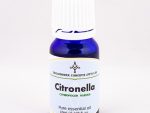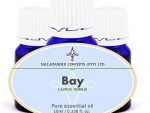Information on Sandalwood essential oil
Sandalwood essential oil (mysore) was mainly sourced from India and is extracted from Santalum album of the Santalaceae family. It is also known as East Indian sandalwood, santal, saunders and sandalwood Mysore.
Sandalwood (Santalum album) is currently being harvested for the oil in Australia from commercial plantations.
Although expensive, Sandalwood Pure Essential oil has wonderful qualities for relieving both chest and urinary tract infections, while assisting the skin in promoting hydration and moisture.
Due to the high cost of this oil, you may want to consider using our Sandalwood Fragrance oil which also contains santalol, although this is made in a laboratory.
It creates a calming and harmonizing effect, while reducing tension and confusion.
Sandalwood is one of the oils used in our spiritual Three Wise Men Oil Blend, specifically blended to mimic this ancient blend that is used to ground the sub-conscious, opening it through the pineal gland to encourage resolution of hidden trauma.
This blend has been thought to encourage balancing and harmonising of the qi.
Also used to bring calm after shock and to help cure bacterial infections, throat infections, yeast infections and skin ulcers.
Oil Properties
Sandalwood pure essential oil has a woody, exotic smell, subtle and lingering aroma. The color is pale yellow to pale gold.
Origin
Sandalwood is an evergreen, parasitic tree that burrows its roots into other trees. It can grow up to 9 meters (30 feet) high and has a brown-gray trunk, many smooth slender branches, leathery leaves and small pink-purple flowers.
It can take thirty to sixty years for a tree to reach full maturity, when it is cut and distilled and the yellowish wood is sold in thin scrapings.
It is agreed that the best sandalwood oil is from Mysore in India, although the Indian government strictly controls the manufacture of the oil and the trees are a highly protected species as they have almost been eradicated by aggressive harvesting.
The documented use of the wood goes back 4000 years and caravans carrying this wood from India to Egypt, Greece and Rome were a familiar sight.
Many temples were built from the wood and the Egyptians used the oil in embalming.
Sandalwood is much in demand as incense and has a calming effect during meditation.
Swahra yoga recommends it for the union of the senses and Tantric yoga for the awakening of sexual energy.
Once Sandalwood was used for making furniture and caskets, but as the tree is nearly extinct, it is only used for the distillation of oil.
Because of the threat of total extinction, this oil is now very well controlled in India – but has caused the price of this very fine oil to soar, and become one of the most expensive essential oils on the market – and for that reason we offer the pure oil, as well as a more affordable blend which contains 25% of the pure oil.
We regret that we very seldom manage to source this oil for sale and usually buy it in small amounts as the oil does not resell very well – probably because of the price and buyer uncertainty.
The market is also filled with unscrupulous sellers who claim that their Sandalwood oil is pure, but on buying the oil we discover that the product has been adulterated or is a completely different essential oil – usually Amarys essential oil containing fragrance and added synthetic santatol, or simply a fragrance blend containing synthetic santalols made from inexpensive sugar sources.
Extraction
Sandalwood pure essential oil is extracted from the chipped heartwood by steam distillation and yields 4 – 6.5 %.
Chemical composition
The main chemical components are santalol, santyl acetate and santalene.
Precautions
It is considered a non-toxic, non-irritant and non-sensitizing oil. Extremely rare cases of photo-allergy have been reported in a Japanese study.
Therapeutic properties
The therapeutic properties of Sandalwood essential oil are antiphlogistic, antiseptic, antispasmodic, astringent, carminative, diuretic, emollient, expectorant, sedative and tonic.
For our glossary and explanation of these therapeutic terms, please click here
Uses
Sandalwood pure essential oil, a relaxing oil, has a harmonizing and calming effect which reduces tension and confusion and is ideal for use in depression, hectic daily lifestyles and states of fear, stress, nervous exhaustion, chronic illness and anxiety.
It is very useful for any chest complaints as it has a pronounced effect on the mucus membranes of both the pulmonary as well as genito-urinary tract – making it very effective for complaints of the urinary tract as well.
Chronic chest infections, sore throats and dry coughs as well as bronchitis and asthma can benefit greatly from this oil, as well as cystitis and bladder infections, also helpful with sexual problems such as frigidity and impotence. On the skin, sandalwood oil relieves itching and inflammation of the skin, and is most effective in relieving dehydrated skin – making it great for anti-ageing skincare – and the astringent action has a great toning effect and is also used with great results in oily skin conditions and to prevent the skin from forming ugly scars and for fighting dry eczema.
Burners and vaporizers
In vapor therapy, sandalwood oil can be used for its aphrodisiac effect, to help clear bronchitis, coughs, chest infections, asthma, insomnia, irritability, nervous tension, stress, tension, for relaxing and as an insect repellent.
Blended in Massage Oil or in the Bath
As a blended massage oil or diluted in the bath, Sandalwood essential oil can assist with bladder infections as well as chest infections and bronchitis, coughs, dry eczema, insomnia, forming scar tissue, irritability, nervous tension, stress, tension, as an aphrodisiac and for relaxing.
Gargle
It can be effective when diluted and used as a gargle for a sore or dry throat.[
Blended in a Cream
When used in a lotion or cream sandalwood oil can assist with chapped, dry or inflamed skin and has wonderful moisturizing and hydrating properties, which are great for anti-ageing skincare. The toning effect is useful when fighting oily skin.
Suggested Dilution Rates
On the skin
Adult:
Face: 0.5% to 1.5%
Body: 1% to 2%
Bath: 1% to 2%
3 to 24 months:
Face: 0.25% to 0.5%
Body: 0.25% to 0.5%
Bath: Maximum of 0.5%
2 to 6 years:
Face: 0.5% to 1%
Body: 0.5% to 1%
Bath: 0.5% to 1%
6 to 15 years
Face: 0.5% to 1.5%
Body: 0.5% to 2%
Bath: 0.5% to 2%
Pregnancy
Face: 0.5% to 1.5%
Body: 0.5% to 2%
Bath: 0.5% to 2%
- When in doubt consult your doctor / medical professional before use.
- Most professionals and/or Aromatherapists will always err on the side of safety when giving advice regarding the use of essential oils and oleo resins during pregnancy.
- Quite a number of Aromatherapists advise that you should avoid all essential oils completely while pregnant, specifically during the first trimester. This is a very safe approach but may not be necessary at all.
Diffusers and Vaporisers
4 to 8 drops
General:
- When using for the first time – Always use the lowest dilution rate and build up slowly to the maximum. Stop using all essential oils on the skin if irritation or allergy occurs.
- Any advice or instruction received from a medical professional ALWAYS supersedes recommendations or advice found on this website. When in doubt consult your doctor / medical professional.
Summary
Sandalwood essential oil can be helpful for the nervous system, for chest and urinary tract infections, for sexual problems and for skin care. Extremely rare cases of photo-allergy have been reported.
Blends
Although essential oils blend well with one another, Sandalwood oil blends particularly well with Bergamot, Black Pepper, Geranium, Lavender, Myrrh, Rose, Vetiver and Ylang-ylang.





